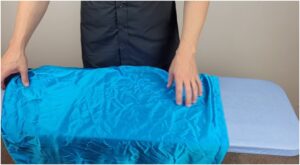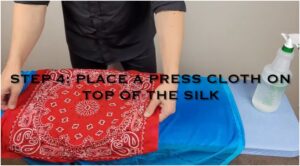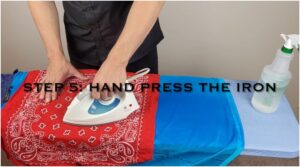
I’ll be honest with you—I once scorched a satin skirt so badly it looked like it had been in a candlelit dinner gone wrong.
One careless swipe of a too-hot iron and my thrifted, jewel-toned treasure turned into a shiny, puckered patch of regret.
That’s when I learned the golden truth: can you iron satin – how to iron satin is not just a question, it’s an art form. And trust me, once you master it, you’ll never fear your satin pieces again.
I’ve been working with fabrics for over a decade, and satin holds a special place in my heart. It’s romantic, timeless, and instantly makes you feel like you’re wearing something worth twirling in. But it also has a diva streak—it demands attention, patience, and the gentlest of touches.
So, here’s my complete guide, drawn from my own mishaps, textile know-how, and a few fashion rescue missions for friends who thought “silk setting” was just a suggestion.
Can You Really Iron Satin Without Damaging It?

Yes, absolutely—but only if you treat it like the luxury fabric it is. Satin isn’t a single fiber; it’s a weave. That glossy, light-catching finish comes from how the threads are arranged, not the material itself. You can find satin made from silk, polyester, acetate, nylon, or blends, and each reacts differently to heat.
This is why your first move is always to check the care label. If your piece says “dry clean only,” it’s not being dramatic—it’s telling you the fibers might warp, melt, or lose their sheen under an iron. But if it gives you the green light, proceed with the gentlest approach possible.
What Should You Do Before You Even Turn on the Iron?

Image source- 1000 Kingdoms | Men’s Silk Shirts and Silk Pajamas
Before I touch an iron to satin, I do a little “fabric spa” prep session. First, I turn the garment inside out.
This isn’t just habit—it’s insurance. Ironing the wrong side protects the glossy finish from heat marks and shine spots that can dull the look.
Next, I lay the piece perfectly flat on my ironing board, smoothing out any folds or lumps. Satin is unforgiving; any wrinkle that sits under heat will press right into place.
I also make sure the ironing board cover is clean—one stray fiber or bit of lint can imprint itself like a tiny tattoo on your satin.
How to Iron Satin Without Stressing About Ruining It
Here’s my tried-and-true method for can you iron satin – how to iron satin moments:
1. Dampen Gently

Lightly mist the fabric with clean water using a spray bottle. The goal is “dewy morning leaf,” not “just fished it out of the pool.” Moisture helps relax the fibers and makes pressing easier.
2. Use a Pressing Cloth

A thin, clean cotton cloth—like a pillowcase or bandana—goes between your iron and the satin. This is your fabric bodyguard, preventing direct contact that could scorch, melt, or alter the texture.
3. Low Heat Is Non-Negotiable

Set your iron to the lowest possible heat—look for “silk,” “synthetic,” or a single dot on the dial. For silk satin, stay closer to 110°C (230°F); for synthetic satin, you can inch toward 150°C (300°F), but always test a hidden spot first.
4. Press, Don’t Slide

Place the iron on the pressing cloth for a few seconds, then lift. Move to the next section and repeat. Dragging can stretch the weave and create new wrinkles. It’s a rhythm—press, lift, shift, repeat.
5. Hang and Cool

Once smooth, hang your garment on a padded hanger in a cool, dry spot. Let it rest before wearing or storing—it’s like letting a good hairstyle “set.”
How to Unwrinkle Satin Without a Steamer?
If you don’t own a steamer (or yours decided to retire mid-outfit), don’t panic. You can still get wrinkles out of satin safely.
Lay your satin garment inside out on an ironing board, place a pressing cloth over it, and use the lowest heat setting on your iron. Lightly mist with water before pressing section by section.
Another trick I’ve used in a pinch is the “shower steam method.” Hang your satin piece in the bathroom while you run a hot shower, close the door, and let the steam naturally relax the fabric. Just keep it far enough from direct water spray.
What Iron Setting Do I Use for Satin?
This is where a lot of people get it wrong. Satin should be ironed on the lowest setting available, usually labeled “silk,” “synthetic,” or represented by one dot on the dial.
For silk satin, aim for around 110°C (230°F). For polyester or blends, you can go up to 150°C (300°F), but never more.
If your iron doesn’t have a dedicated satin setting, always start cooler and increase gradually if needed. Too hot and you risk permanent shine marks or melted fibers.
Is Steaming a Better Option for Satin?

Sometimes, yes. I love steaming satin for quick touch-ups or delicate vintage finds. A handheld steamer held a few inches away can ease out wrinkles without the risk of heat marks.
Even the steam from a hot shower works in a pinch—hang your garment, close the bathroom door, and let the magic happen.
That said, steaming doesn’t always give the crisp finish you might want for structured satin pieces like blazers or pleated skirts. For those, a careful press is still your best bet.
Ironing vs. Steaming Satin – Which Should You Choose?
| Aspect | Ironing Satin | Steaming Satin |
|---|---|---|
| Best For | Structured satin pieces (pleated skirts, blazers) | Flowy or delicate satin (blouses, slip dresses) |
| Heat Risk | Moderate risk if heat is too high | Low risk if kept at safe distance |
| Finish Quality | Crisp, defined finish | Soft, natural drape |
| Speed | Moderate – requires prep | Fast for quick touch-ups |
| Wrinkle Removal Strength | Strong for deep wrinkles | Good for light to moderate wrinkles |
| Fabric Safety | Safe if using pressing cloth & low heat | Very safe if not over-steamed |
| Tools Needed | Iron, pressing cloth, ironing board, spray bottle | Handheld steamer or shower steam |
| Ideal Garments | Formal wear, gowns, tailored satin | Casual satin tops, skirts, lingerie |
What Mistakes Should You Avoid When Ironing Satin?
The biggest sin? High heat. It’s like sunburn for your fabric—irreversible and painfully obvious. Also, never iron the glossy side directly. The heat can flatten the weave’s texture, making it look dull in spots.
Avoid pressing over embellishments, zippers, or seams without adjusting your pressure. And never skip the pressing cloth. That’s like going out in July without sunscreen—bold, but asking for trouble.
FAQs About Ironing Satin
Q: Can I iron satin blends the same way as pure silk satin?
Not exactly. Polyester satin is generally more heat-resistant than silk satin, but I still recommend the lowest setting. Always test on an inconspicuous spot before committing to a full press.
Q: How do I prevent my satin from getting shiny patches when ironing?
Shiny patches usually happen when the glossy side gets direct heat. Always iron on the wrong side with a pressing cloth. If you see shine forming, stop immediately and switch to steaming.
Q: Can I use steam directly from my iron on satin?
Yes, but with caution. Keep the iron moving and never let the steam linger in one spot. Some satins can get water spots, so test first. I often prefer a handheld steamer for more control.
Q: What if my satin has stubborn wrinkles that won’t budge?
Try dampening the area slightly more, then pressing with the lowest safe heat. If that fails, steaming while gently pulling the fabric taut usually works wonders.
The Satin Glow-Up Is Worth It
Ironing satin isn’t just about making it wrinkle-free—it’s about preserving its elegance so you can keep wearing it for years.
When you take those extra minutes to prep, protect, and press with intention, you give your satin pieces the respect they deserve.
And honestly? There’s nothing like slipping into a freshly pressed satin dress or blouse.
It feels luxe, confident, and a little bit magical—like you’ve stepped straight out of a vintage Hollywood scene.
So next time you ask yourself can you iron satin – how to iron satin, remember: the answer is yes, if you treat it like the star of your wardrobe.



